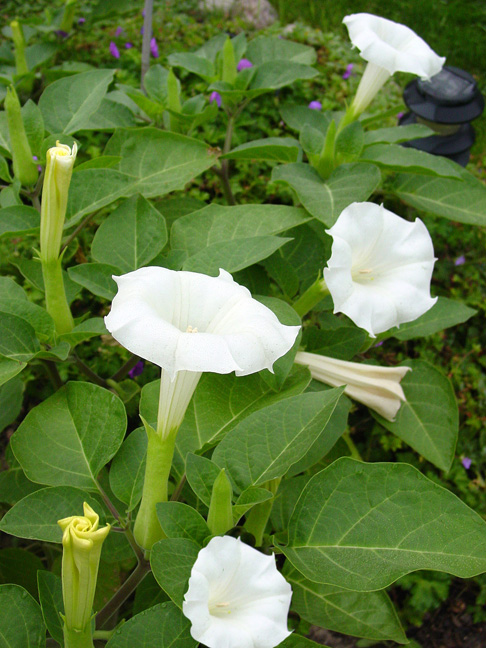I have grown Moonflowers (Datura) in my garden for a few years now. Datura is a woody-stalked, leafy herb that gets about 36 inches tall in my yard. It produces spiny seed pods and truly spectacular white trumpet shaped flowers that face upward. They bloom in July and continue into September in my yard and I use them to over plant the daffodils in an effort to hide the foliage as the daffodils finish their cycle. It is a great way to fill in a section of the garden that looks great in spring and then sort of messy for a long time. They do reseed a bit, but are very slow to emerge. Each year just when I think they have disappeared, they finally send up the first green shoots and start to grow. They like warm temperatures and do very well in my perennial flowerbed.
Garden Tips
Datura are able to change size of plant, size of leaf, and size of flowers, all depending on location. In my yard the same species, with enough rain or generous watering top out at about 3 feet. However, when I plant them in a dry location in the yard that is hard to water, they stay much smaller and produce a thin little plant with tiny nondescript flowers and a few miniature leaves.
Common Names
Jimson Weed; Devil’s Apple; Thorn Apple; Stinkweed; Devil’s Weed; Malpitte; Moonflower; Toloache (D. inoxia) Most parts of the plant contain atropine, scopolamine, and hyoscyamine. It has a long history of use both in S. America and Europe and is known for causing delirious states and poisonings in uninformed users.
Medical Information
Due to their agitated behavior and confused mental state, victims of Datura poisoning are typically hospitalized. Stomach pumping and the administration of activated charcoal can be used to reduce the stomach’s absorption of the ingested material. The drug physostigmine is used to reverse the effect of the poisons. Benzodiazepines can be given to curb the patient’s agitation, and supportive care with oxygen, hydration, and symptomatic treatment is often provided. Observation of the patient is indicated until the symptoms resolve, usually from 24–36 hours after ingestion of the Datura.
When I read all of the medical information about Datura poisoning, I couldn’t help but wonder why in the world would anyone eat that plant!





Lovely…Must try them next summer…